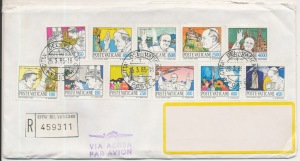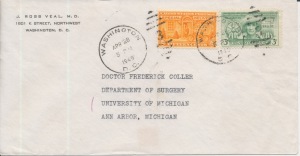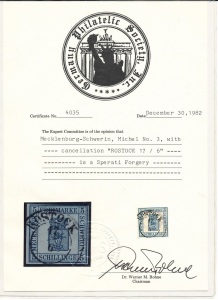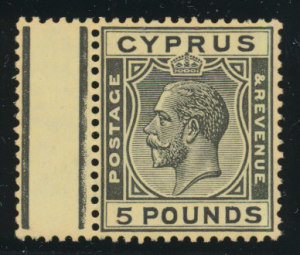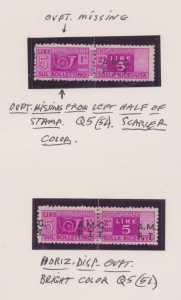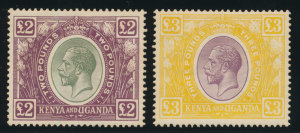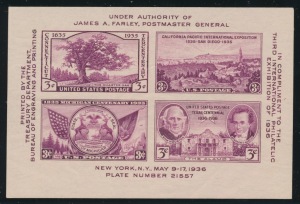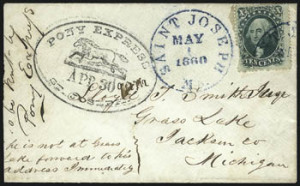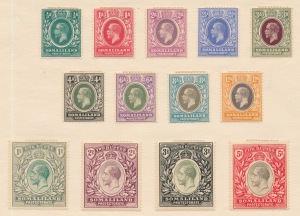Special Event or Commemorative covers are an envelope, with an artistic cachet, canceled with a stamp that honors and event or special occurrence. Special Event covers have been in the philatelic news lately as they have been issued quickly to honor the investiture of the new Pope. Special Event covers exist for Papal inaugurations, Presidential inaugurations, Royal Weddings, births-in fact anyone can design an envelope for anything, add a stamp and you have a Special Event Cover.
Covers of this type have a long and varied history. The idea of a design on a cover, either germane to the subject at hand or allegorical, goes back to the first stamp issue-the Mulready envelopes which Rowland Hill had devised to compete with the Penny Black in 1840, and which never really caught on. Throughout the nineteenth century covers were used with designs on them to make political or business points. This was most common
Monthly Archives: September 2017
- Posted September 29, 2017Read more »
- Posted September 28, 2017Read more »The goal of the Postal Service has always been speed. The history of mail delivery, from the Roman postal roads to overnight service, has been one of ever increasing rapidity of written communication. Time is money, and the value of the post, especially in the post-1840 philatelic period, has been the ever increasing availability of rapid, inexpensive communications to ordinary people and businesses. Mail delivery was fast in nineteenth century America—certainly when compared to earlier eras. Letters within cities were often delivered the same day (there were three daily deliveries in downtown Philadelphia, for instance, in 1900), and mail was two days between major eastern cities and five days coast to coast—not bad for 2¢ postage in a time before airplanes. But even that wasn't fast enough, and by 1885 the Post office offered an even faster delivery system—Special delivery, which offered expedited service for around five times the cost of regular mail. Special Delivery
- Posted September 26, 2017Read more »Philately lacks drama. Maybe that's why stamp collectors love a good scandal in our hobby. Though philatelists tend to differ in opinion on what constitutes a good stamp scandal, most will agree that a good scandal must be international in scope, affect thousands of collectors, and defraud collectors of large amounts of money. By these standards most of today's issues qualify as irritants or distractions. All will agree though that there have been three major philatelic frauds in the history of our hobby.The first major stamp scandal became well known just after the turn of the twentieth century. Stamp collecting was becoming the popular hobby it is today, and prices for earlier material that had never been saved in much quantity was going
- Posted September 25, 2017Read more »While Francois Fournier was a philatelic facsimile maker whose work fools only novices or collectors who have never seen the real thing, Jean de Sperati spent his life creating forgeries designed to undermine the most knowledgeable philatelists. Even his book that he wrote Philatelie sans Experts (Philately without Experts) shows his prime motivation was the thrill of creating forgeries that even great experts couldn't tell. And Sperati's work is good, so good, in fact that until about 1920, when it became known that he was doing forgeries, stamps that he made in his workshop would routinely get certificates of genuineness from the most prestigious certifying boards. Sperati's work was a passion. He engraved his stamps from scratch—a process that took months. He bought sheets of genuine stamps (of cheaper values in a set) so that he could use the selvage for printing his forgeries so that the paper and watermark would be the same as the original. Indeed, one
- Posted September 22, 2017Read more »Philatelic scandals come in three sizes—small, medium, and large. The work of Francois Fournier, prolific forger from Switzerland, ranks as a major philatelic scandal. He made hundreds of thousands of reproductions of many of the most popular and collected stamps in the hobby and defrauded, either directly or indirectly, tens of thousands of collectors out of millions of dollars. That is a large scandal. Jean de Sperati was a far finer artisan in his forgery work than any other who ever lived. He made detailed engraved plates by hand and was careful in his use of paper and duplicated watermarks. A man with his artistic skill set could have made far more money (and certainly had legitimate fame) in fine arts restoration, even if he were not creative enough to be an artist himself. But Sperati played small ball. His production was limited in numbers of stamp types forged and quantities produced. And, though he never had admitted it, he was pleased
- Posted September 21, 2017Read more »
The situation took place couple of years ago, but may as well have happened yesterday, we got a call from a Thrift Shop in the Hatboro area, a small town just a few miles from our office. The shop had been given a collection that they felt was pretty valuable, and they wanted us to look at it. They were very upfront about the terms of sale which were as follows—the collection was open to bid, high bids would be revealed (they originally had said that there would be sealed bids, but when we went to see the stamps, it was pretty clear that they were prepared to reveal all bids), and bidding was to remain open for seven business days after the last bid that topped a previous bid was received. We went to see the collection, as it was close and there appeared to have some
- Posted September 19, 2017Read more »It is a curious fact, mostly to do with poorly designed and implemented rules, that banking crises in tiny countries can bring the world financial system nearly to collapse. Places like Iceland and Cyprus, which were more well known to philatelists than to the general public, have been given the power (by the European Union's bizarrely lax banking rules) to take deposits that essentially have the guarantee of the European central bank (and behind that, the full faith and credit of the Bundes bank of Germany). Thus, over the last decade, Germany continues to bail out smaller and weaker economies and have more and more say in how those countries run their internal affairs. Does anyone doubt that the period since the Franco-Prussian War of 1870 (including WWI and WWII) will be called, by future historians, the Wars of European Unification, and that the winner, and power in unified Europe, is Germany?
- Posted September 14, 2017Read more »
 Open your newspaper or look online, and hardly a day goes by in which some new CNN or Bloomberg poll isn't measuring some aspect of American life. How much time do we spend watching TV? Or exercising? Or intending to exercise as we watch TV? Nearly every aspect of our lives is polled and measured and evaluated, and if the polls are to be believed, we are a nation of people who say they never have enough time to do the things that they want and yet who seem to be able to have the TV set on eight hours a day.Hobbies in general, and philately in particular, are so small a part of most people's lives that they never even seem to be asked about by pollsters. Hobby websites that ask readers to participate in polls report that average hobbyists spend about
Open your newspaper or look online, and hardly a day goes by in which some new CNN or Bloomberg poll isn't measuring some aspect of American life. How much time do we spend watching TV? Or exercising? Or intending to exercise as we watch TV? Nearly every aspect of our lives is polled and measured and evaluated, and if the polls are to be believed, we are a nation of people who say they never have enough time to do the things that they want and yet who seem to be able to have the TV set on eight hours a day.Hobbies in general, and philately in particular, are so small a part of most people's lives that they never even seem to be asked about by pollsters. Hobby websites that ask readers to participate in polls report that average hobbyists spend about - Posted September 12, 2017Read more »
When I was an annoying teenager helping out at the Apfelbaum stamp store in the 1960s, every Saturday brought in the fascinating Ken Whittle. Ken was the kind of philatelist that you saw a lot of then. He was the archetype of the "solitudinous collector" (or SC). SC's are people for whom philately is very important and who are putting together important collections which they rarely talk about. Mr. Whittle was extremely well educated and worked as an engineer for Dupont in Wilmington (doing something with fractions of petroleum), was unmarried, and lived—full time—at a small residential hotel in Wilmington. When I knew him in the 60's, he was always neat as a pin with a well groomed little mustache. He came in, took off his hat and coat, and to my "Good Morning, Mr Whittle" would always (and I mean always) respond "Greetings and salutations, young man"
- Posted September 11, 2017Read more »
Philatelic popularity began a long, measurable ascent about 1900. An historian can see the hobby taking off, and we know that the numbers of collectors increased because we see an increase in the number of philatelic magazines, in the quantity of different stamp albums, increased membership in collector societies and more stamp dealers. As these quantifiable measurements of the appeal of our hobby have fallen off in recent years, the idea that our hobby is losing adherents has been gaining traction. But the evidence is really not that clear.
It is true that the number of APS members and Linn’s subscribers are down. There are fewer, less well attended stamp shows than there used to be. Stamp dealer offices used to exist in all major cities where they seldom - Posted September 08, 2017Read more »One of the constants in history is the malleability of political boundaries. In America, we have become a bit inured to this fact because our own geography has been so steady, adding only Hawaii and Alaska to our country in the last century. But Europe is used to change, and nowhere in Europe has there been more change than in the Balkan area. Trieste is a city that lies at the end of the Adriatic and has had many masters during its history.Trieste began the stamp period as part of the Austro-Hungarian empire. As such, like any city in the empire, it used Austrian stamps. After WWI, Austria ceded the area that included Trieste to Italy, and the importance of Trieste as a commercial center declined. Trieste had been an important port city
- Posted September 07, 2017Read more »When collectors rail about excess new issue stamps soaking up their collecting budget and leaving them with little to spend on older stamps, they are only part of a long tradition of collectors who have bought stamps for their collections that were issued for reasons other than postal need. Some of the most popular stamps in all of philately, the George V and George VI high values, fit this description. When they were first issued, the enormous face values of some of the stamps (even up to as much as 100 Pounds postage value, a sum equal to the average annual wage for a construction worker in 1920-1930, the years such stamps were being issued) cause dolorous denunciations in the philatelic press.
- Posted September 05, 2017Read more »Stamps were a hot hobby in the 1930s, and how hot is best illustrated by the fate of two United States Souvenir sheets that were issued three years apart. When the APS sheet was issued in 1933, the hobby was just beginning its Great Depression ascent. The face value of the sheet was only 12¢, but quantities were not saved. When collectors began to demand the sheet, the stocks that dealers had on hand were soon exhausted, and prices rose rapidly. Today, it catalogs $32.50. By the time the 12¢ TIPEX souvenir sheet was issued three years later, collectors and dealers were putting away big stocks of each new issue, and this stamp was one of many from the mid to late 1930s that got put away. Today, with the same face value as the earlier sheet, it catalogs only $1.75. Even today, nearly 80 years later, quantities of thousands exist that have never been in collections and which have been bundled up in groups and still reside in dealer stocks.
- Posted September 04, 2017Read more »Cover collecting did not begin at the same time as did stamp collecting. Philately had its start in earnest about 1860, and, really, until about 1910, cover collecting was something collectors did when they didn't have the time to wash the stamps they needed for their collections off the envelopes on which they had bought them (this is why so many earlier stamps are so much rarer on cover than off). In a few cases, such as Pony Express covers or Civil War Patriotics, much of the collecting interest had to do with the cachet on the envelope and the usage that the cover received (rather than the stamp) so that there were a few early cover savers. But serious postal history collecting had to wait until the efforts of Henry Gibson, Sr. Gibson was the first collector who looked for rare usages of stamps on covers and assembled a major collection that was sold in the early part of the twentieth century. It was his financial success as a cover collector that began the impetus for the second great
- Posted September 01, 2017Read more »If you like stamps and stamp history, working on old collections is one of the most interesting things that you can do. Couple of years back we purchased a collection that had been made in the 1930s and had been passed down through the generations with considerable care, if not interest, on the part of the new owners. The last owner was an 85 year old grandson of the original collector.The collection is interesting for two reasons. First, the original collector never used albums, but rather kept most of the stamps that he bought on the original lot pages as he purchased them over 80 years ago. The collector was a loyal George Sloane customer. His choice of dealers was a very good one. Sloane was the among the best of his generation, running a large auction

